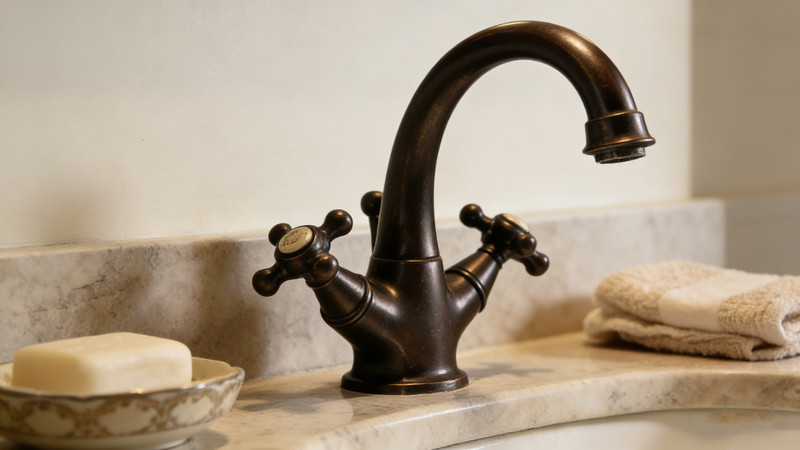
A leaking water filter faucet can be a frustrating problem, especially if you’re relying on it for clean and filtered drinking water. Fortunately, most leaks are easy to fix with a little troubleshooting and basic tools. In this guide, we’ll walk you through the steps to diagnose the cause of the leak and provide solutions of how to repair a leaking water filter faucet. Whether it’s a simple tightening or a more complex issue with the faucet’s components, we’ve got you covered.
Common Causes of Water Filter Faucet Leaks
There are several reasons why your water filter faucet might be leaking. Identifying the cause will help you fix the issue efficiently. Here are the most common culprits:
- Loose or damaged connections
- Worn-out O-rings or washers
- Clogged or damaged filter cartridges
- Cracked or broken faucet components
How to Repair a Leaking Water Filter Faucet
Let’s explore each issue in more detail and go over how to repair them.
1. Loose or Damaged Connections
A common cause of leaks in water filter faucets is loose or improperly connected fittings. Over time, connections between the faucet, filter, and plumbing can become loose due to water pressure or regular use. Fortunately, this is usually one of the easiest fixes.
Steps to Fix Loose Connections:
- Turn off the water supply: Before working on your water filter faucet, ensure the water supply to your filter system is turned off. This will prevent water from spraying while you work.
- Inspect the connections: Check all visible connections, including those at the base of the faucet, under the sink, and between the water filter and faucet. Look for any signs of leaks or moisture buildup.
- Tighten loose connections: Use a wrench or pliers to tighten any loose nuts or fittings. Be cautious not to over-tighten, as this can damage the components.
- Check for cracks: While inspecting the connections, also check for any cracks in the fittings. If you find any, you’ll need to replace the damaged parts.
Testing the Fix:
Once the connections are tightened, turn the water supply back on and test for leaks. If the leak persists, move on to the next troubleshooting step.
2. Worn-Out O-Rings or Washers
O-rings and washers are essential components in any faucet, acting as seals to prevent water from leaking. Over time, they can wear out, become brittle, or develop cracks, leading to leaks. This is particularly common in older faucets or faucets that are used frequently.
How to Fix Worn-Out O-Rings or Washers:
- Turn off the water supply: As always, shut off the water supply before disassembling the faucet.
- Disassemble the faucet: Depending on the design of your water filter faucet, you may need to remove the handle or spout to access the O-rings or washers. Use a screwdriver or wrench to carefully disassemble the faucet.
- Inspect the O-rings and washers: Check for signs of wear or damage. If they appear cracked or flattened, it’s time to replace them.
- Replace the O-rings or washers: Purchase replacement O-rings or washers that match the size and type of your faucet. Apply a bit of plumber’s grease to the new O-rings before installing them to ensure a tight seal.
- Reassemble the faucet: Once the new parts are installed, reassemble the faucet and tighten everything securely.
Test for Leaks:
Turn the water back on and check if the leak is fixed. If it’s still leaking, you may need to check the water filter faucet components for other issues.
3. Clogged or Damaged Filter Cartridges
If your water filter faucet cartridge becomes clogged or damaged, it can cause pressure to build up in the faucet, leading to leaks. Regular maintenance and timely replacement of filter cartridges can prevent this issue.
Steps to Fix Clogged or Damaged Filter Cartridges:
- Turn off the water supply: As with other repairs, start by turning off the water.
- Remove the filter cartridge: Most water filter systems have a simple mechanism for removing the cartridge. Follow the manufacturer’s instructions for your specific model.
- Inspect the filter cartridge: Check the cartridge for signs of clogging, such as discoloration, residue buildup, or deformities. If the filter is past its replacement date or shows signs of damage, replace it with a new one.
- Install the new filter: Follow the instructions provided with your new filter to install it correctly. Be sure to tighten all connections to prevent future leaks.
Testing the Fix:
Turn the water back on and see if the faucet is still leaking. If the leak persists, the issue may lie within the faucet itself.
4. Cracked or Broken Faucet Components
In some cases, the water filter faucet itself may be the source of the problem. Cracks in the faucet body or spout can allow water to leak, and sometimes internal components like cartridges can fail.
How to Fix Cracked or Broken Faucet Components:
- Turn off the water supply: As always, begin by turning off the water supply to prevent any further leakage.
- Inspect the faucet for cracks: Visually inspect the faucet, especially areas around the spout and base, for cracks or signs of wear. Also, check for any damaged internal components if you have already disassembled the faucet.
- Replace damaged parts: If you find any cracks or broken parts, you’ll need to replace them. For minor cracks, you may be able to use plumbing tape or sealant as a temporary fix, but replacement is usually the best option.
- Consider replacing the faucet: If the faucet is severely damaged or outdated, replacing the entire faucet might be more cost-effective than repairing individual parts.
Testing for Leaks:
Once the damaged parts have been replaced, turn the water back on and check for leaks. If everything is sealed properly, the leak should be gone.
Preventive Tips to Avoid Future Leaks
Preventing future leaks involves routine maintenance and care for your water filter faucet. Here are a few tips to help you avoid problems down the line:
- Regularly check connections: Make it a habit to inspect the faucet and filter system connections periodically. Tighten any loose fittings to avoid leaks.
- Replace filters on time: Follow the manufacturer’s recommended schedule for replacing filter cartridges.
- Clean and maintain the faucet: Keep the faucet clean and free from debris, which can cause wear and tear on seals and components.
- Use quality parts: When replacing parts like O-rings, washers, or cartridges, opt for high-quality replacements to ensure longevity and a proper fit.
Conclusion
Fixing a leaking water filter faucet is usually a straightforward process, whether it involves tightening connections, replacing worn-out components, or addressing more complex issues like damaged parts. By following the steps outlined in this guide, you can restore your faucet to proper working condition and enjoy leak-free filtered water once again. Regular maintenance and attention to detail will also help you prevent future leaks, ensuring your water filter system remains reliable for years to come.
 WOWOW Faucets
WOWOW Faucets





